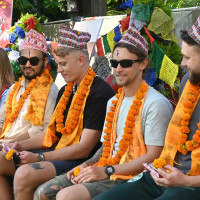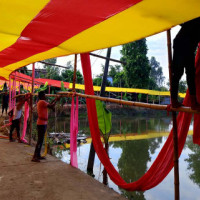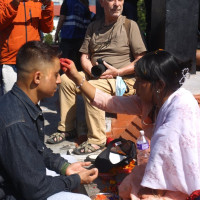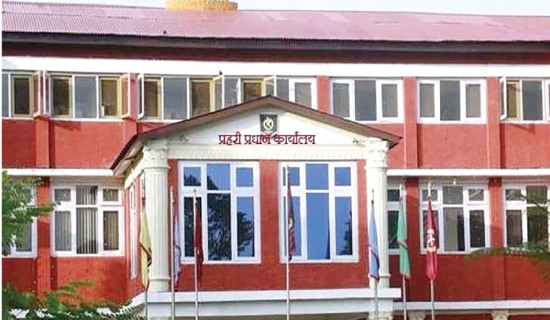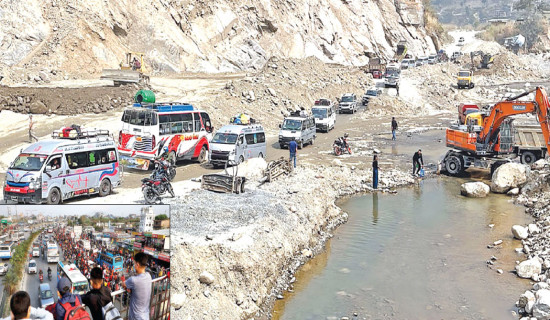- Friday, 24 October 2025
Manual signal is solution as many traffic lights don't work in Valley
Kathmandu, Apr. 4: As of today, the Kathmandu Valley has just 69 traffic lights in different road intersections. However, not all of them function regularly or in an automated way. Because of the lack of fully operational automated traffic signals, traffic management in the Capital continues to rely on manual signaling (hand-driven) by traffic police rather than a systematic, and signal-based system.
As a result, traffic police personnel can be seen constantly engaging in ensuring smooth transportation in the Capital, tirelessly working amidst smoke and dust of vehicles relying solely on hand signals and whistles.
Traffic police personnel themselves concede that Valley's all traffic lights don't function simultaneously and automatically as intended every day.
Traffic lights installed at busy intersections in the capital, such as Jadibuti Chowk, Airport Golden Gate in Sinamangal, Subidhanagar, and Gaushala Chok are out of order for past six days after pro-monarchy street demonstration on March 28.
These are just a few traffic lights that have stopped working due to specific reasons. Out of the total 69 traffic light locations in the Valley, only 36 are currently operational. The lights at other locations have been out of service for a long time due to malfunctions, said engineer and Deputy Superintendent of Police (DSP) Amarendra Singh at the Kathmandu Valley Traffic Police Office, Ramshahpath.
"It is almost impossible to run our traffic lights fully in an automatic way round the clock as every road and intersection has its own woes of traffic pressure," claimed Singh.
Because of the lack of resources, equipment, and sufficient manpower, both the traffic police and the public have to endure daily hardships.
Traffic lights in 33 places out of order
Besides, temporary shutdown of traffic lights in Jadibuti, other traffic lights in Koteshwar, Ghaushala, Subidhanagar, among others in the Capital, are also not functional.
Although the underpass in Kalanki had helped a lot in managing smooth traffic management, during the evening hours it is challenging to ensure smooth transportation during office hours and in the evening in Kalanki intersection, said officials. The Kalanki section is now equipped with traffic lights and have been coming into operation 24/7 hours, said traffic police office.
Across most roads in the Kathmandu Valley, traffic lights either malfunction or remain inoperative every day, which is also one of the main reasons for traffic jam during the office and evening hours, said traffic policemen.
According to Superintendent of Police (SP) and Spokesperson for the Kathmandu Valley Traffic Office, Ramshahpath, Dipak Giri, as of today, 33 traffic lights in different places have gone out of order. However, due to public non-compliance, officers are still required to be physically present at these sites. Every day, approximately 1,740 traffic police personnel (out of total 1,800 manpower) are deployed to manage vehicular movement in the capital.
"Drivers often disregard traffic lights, making it essential for officers to be stationed at every major intersection," stated Spokesperson Giri. "As a result, daily traffic fines generate over 1.5 million rupees in revenue." At intersections where traffic lights are non-functional, four to five officers are assigned, while other junctions typically require two, he said.
No matter how much technology is added to Kathmandu's traffic lights, traffic congestion continues to increase due to several factors. These include the lack of timely road improvements and upgrades, poor management of corridors, lack of road discipline among drivers, improper use of footpaths by pedestrians, the absence of subways, rapid urbanisation, and the haphazard stopping of vehicles by ride-sharing services like Pathao and In-drive without following proper pick-and-drop rules.
Additionally, periodic street protests, rallies, and processions during festivals also contribute to traffic congestion, said SP Giri.
According to him, an estimated 80,000 to 100,000 new vehicles are added to the city’s streets each year. Currently, over 1.8 million registered vehicles operate within Kathmandu. SP Giri said, "Since 800,000 to 1 million vehicles run on the roads of Kathmandu daily, one traffic police has to monitor over 588 vehicles each day."
The Japan International Cooperation Agency (JICA) first installed traffic lights at 20 intersections in 1966. Subsequently, in 1993, the Japanese government expanded the system, adding signals at Thapathali, Tripureshwor, Maitighar, Padmodaya Mode, New Baneshwor, Koteshwor, Satdobato, Keshar Mahal, Lainchaur, Maharajgunj, and along the Ring Road.
Currently, JICA has been installing three traffic lights in Kesharmahal, Lainchaur and near the Department of Mines and Geology, informed engineer DSP Singh.
According to officials from the Department of Roads, maintaining these dysfunctional traffic lights is cumbersome. "Traffic lights need to be upgraded with modern technology," said Rakesh Maharjan, chief of Road Safety and Traffic Section under the Department of Roads. "Malfunctions are often caused by software failures rather than hardware issues, as the physical components are generally durable for years."
The responsibility for installing and maintaining traffic lights falls under the Department of Roads. However, municipal authorities and other organisations occasionally install additional lights. While traffic police oversee the control room and monitoring systems, repairs for malfunctioning lights are managed by the Department of Roads. raffic systems consist of both software and hardware components. The timing of signal change must synchronize with traffic control systems. Engineer DSP Singh explained that some lights fail due to outdated software or system incompatibility with the road network. Even newly installed systems sometimes experience shutdowns due to synchronization issues, making immediate repairs difficult.
While the Department of Roads is responsible for major intersections and highways, local roads fall under the jurisdiction of municipal or ward offices, said Maharjan.
According to the Department, it had so far invested approximately 35.6 million in traffic light installations within the Kathmandu Valley. According to the Department, setting up a single traffic light system costs between Rs. 1.5 to 2 million.




